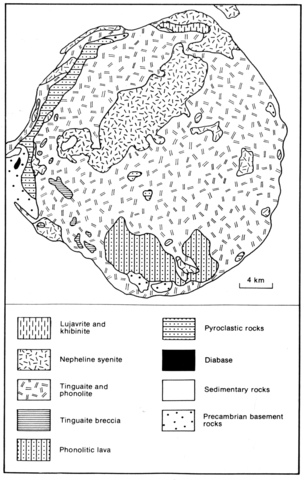stripes
Pocos de Caldas is an approximately circular intrusion covering some 800 km2 and is thus the largest alkaline complex in Brazil and one of the largest in the world. It is emplaced mainly in Precambrian basement rocks, but also partly into Jurassic Botucatu sandstones. Volcanics and sediments occur within the complex, mainly close to the western and southern contacts, and these are older and appear to represent remnants of a roof. The volcanics include tuffs, breccias, agglomerates and ankaratritic lavas, while the sediments are shales and sandstones. Intrusive tinguaite/phonolite constitutes 78% of the complex with nepheline syenite 13.5%, phonolitic lavas 5%, volcanoclastics 3% and lujavrite and khibinite 0.5%. Nepheline syenites have intrusive boundaries with tinguaite. In the northern part of the intrusion are two small bodies of eudialyte-bearing lujavrite and khibinite surrounded by nepheline syenite; the complex relationships of the more westerly, sheeted body have been mapped and described by Ulbrich et al. (1977). These are K-feldspar-bearing rocks with abundant nepheline, analcime (0-11%), sometimes a little albite, variable amounts of natrolite and cancrinite, eudialyte (0-11%), aegirine and accessory arfvedsoniite, biotite, rinkite, lamprophyllite, astrophyllite, catapleite, sphene, fluorite, opaques and some unidentified species. An account of the nepheline syenites will be found in Ulbrich et al. (1984) and of the mineralogy and petrology of these rocks in Ulbrich (1983). Hydrothermal alteration and ore deposition affected all the rocks but mainly inner tinguaites and nepheline syenites. Alkaline volcanics, probably related to Pocos de Caldas, are found intercalated in sediments 12 km to the north (Oliveira et al. 1975).
AMARAL, G., BUSHEE, J., CORDANI, U.G., KAWASHITA, K. and REYNOLDS, J.H. 1967. Geochimica et Cosmochimica Acta, 31: 117-42.
APS, V. and BORN, G.H. 1975. Pesquisa do minerio fosfatico de Ipanema. Geologia e Metalurgia, Sao Paulo, 37: 24-34.
BUSHEE, J.M. 1974. Potassium-argon ages of some alkaline rocks from southern Brazil.Thesis (unpublished), University of California, Berkeley. 145 pp.
ELLERT, R. 1959. Contribuicao a geologia do macico alcalino de Pocos de Caldas. Boletim da Faculdade de Filosofia Ciencias e Letras, Universidade de Sao Paulo, Geologia, 237(18): 1-63.
KAWASHITA, K., MAHIQUES, M.M.de and ULBRICH, H. 1984. Idades Rb/Sr de nefelina sienitos do anel norte do macico alcalino de Pocos de Caldas, MG-SP. Resumos, Congresso Brasileiro de Geologia, 33: 244-5.
OLIVEIRA, A. da S., FERNANDES, C.A.C., ISSLER, R.S., ABREU, A.S., MONTALVAO, R.M.G. de and TEIXEIRA, W. 1975. Folha NA.21 Tumucumaque e parte da Folha NB.21. DNPM Projeto Radambrasil.Levantamento de Recursos Naturais, Geologia 1: 1-367.
ULBRICH, M.N.C. 1983. Aspectos mineralogicos e petrologicos de nefelina sienitos do macico alcalino de Pocos de Caldas, MG-SP. Thesis (unpublished), Instituto de Geociencias, University of Sao Paulo. 369 pp.
ULBRICH, H.H.G.J., ULBRICH, M.N. and BAGNOLI, E. 1977. Contributions to the petrology of the Pocos de Caldas alkali massif, Brazil. I: petrography and structure of the Pocos de Caldas lujavrite (unpublished). 42 pp.
ULBRICH, M.N.C., GOMES, C.B. and ULBRICH, H.H.G.J. 1984. Nefelina sienitos do macico alcalino de Pocos de Caldas, MG-SP: caracterizacao mineralogica e petrologica. Anais Congresso Brasileiro de Geologia, 33: 4362-76

